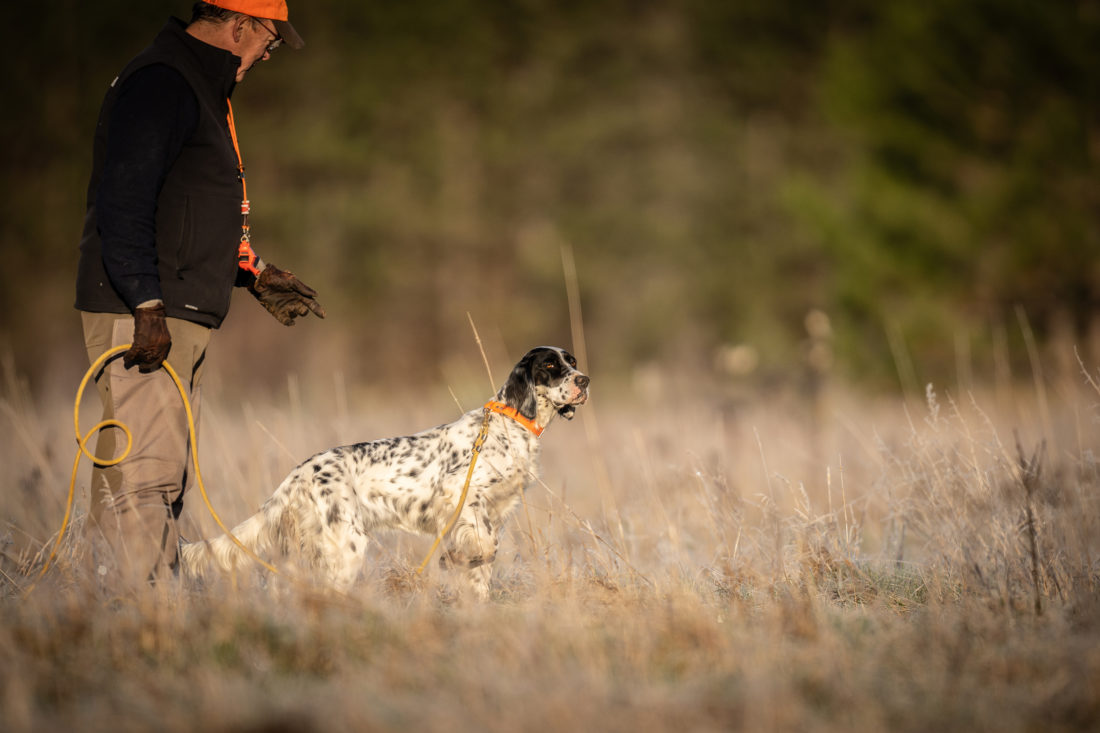A co-founder of Upland Gun Company and the owner of Pineridge Grouse Camp in Minnesota, Jerry Havel has seen first-hand the rise in interest in pointing dogs and upland bird hunting over the last few years. For those new to the sport, Havel underscores the importance of basic obedience work before venturing into hunt-specific skill training. But once a pointing dog knows “come,” “sit,” and “stay,” it is time to introduce the “whoa” command. It’s a critical skill pointing dogs must have down cold: When the dog handler says “whoa”—no matter the situation—the pup needs to hit the brakes. Every time.
“‘Whoa’ is the foundation to start getting the dog to point,” Havel explains. “It harnesses the dog’s natural prey drive and channels it into a positive behavior for a hunting dog.” He starts the training at home, as he feeds a puppy. Havel’s wife will place a bowl of food at the end of a long hallway, and Havel will work the puppy on a lead, pulling the dog to a stop every time he says “whoa.”

Havel at work with one of his pupils.
The skill is a must-have whether the hunt is for wild or pen-raised birds. With both, a dog must learn to stop whenever it hits bird scent. But wild birds are less forgiving of a pointing dog that crowds them.“The number-one goal of a wild bird is to stay alive,” Havel says. “They will flush much more readily than pen-raised birds.” For a group of ten or fifteen wild bobwhites, the scent cone—that space where scent can be picked up by a dog—can sprawl out quite a bit. The birds are more active feeders than pen-raised birds and often move farther distances. A well-trained dog, Havel says, “might point a covey that’s actually thirty yards in front of the dog, and that’s an ideal situation.” The dog isn’t getting too close to the birds, giving hunters time to set up for the flush.
For a pointing dog hunting pen-raised birds, sometimes the challenge isn’t the dog crowding the covey and forcing a flush away from the hunters, but a bird dog that gets so close to its quarry that safety becomes an issue. Pen-raised birds that aren’t “flight conditioned” and used to taking to wing will be slower to escape a dog that breaks and tries to catch its quarry. “With pen-raised birds you can get individuals that are really low fliers,” Havel says. Early in the morning, if they are wet from dew, these birds will often run before they fly. “Having a dog that’s steady to both wing and shot is even more important when you’re hunting for pen-raised birds,” Havel says. “Everybody gets excited on that flush and rise, but we all can afford chicken. There’s no reason to get a dog shot by being excited about the flush.”
And with a growing interest among upland hunters in the use of flushing dogs such as English cockers, more complexity is added to the mix. Now the pointing dog must remain steady while a flushing dog races around in front, attempting to fine-tune the location of the birds and drive them to flight. Training a dog to have a rock-steady obedience to “whoa”—and stay steady to the rise—becomes even more critical when a pointing dog has to honor a companion who gets the fun of flushing the birds.
This story is part of a series of articles on sporting dog training tips from Eukanuba Pro Trainers. See the series here:
>> Advice for a Young Dog’s First Dove Hunt
>> Introducing a Bird Dog to Noises and Water
>> Retriever Training at the Clays Course
>> The Importance of “Whoa” for Bird Dogs
"bird" - Google News
September 06, 2022 at 10:30PM
https://ift.tt/gZQqaoU
The Importance of “Whoa” for Bird Dogs – Garden & Gun - Garden & Gun
"bird" - Google News
https://ift.tt/4CKkSZe
https://ift.tt/rbPiufD
Bagikan Berita Ini














0 Response to "The Importance of “Whoa” for Bird Dogs – Garden & Gun - Garden & Gun"
Post a Comment